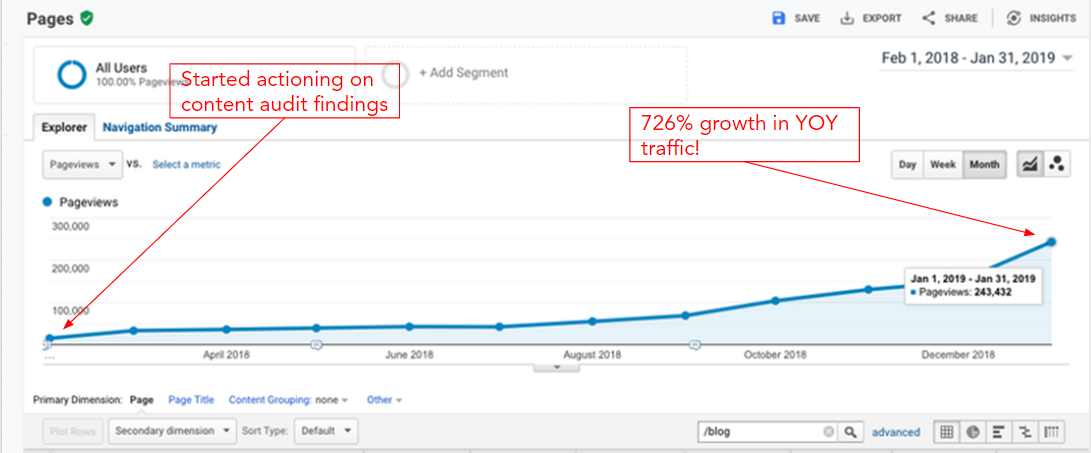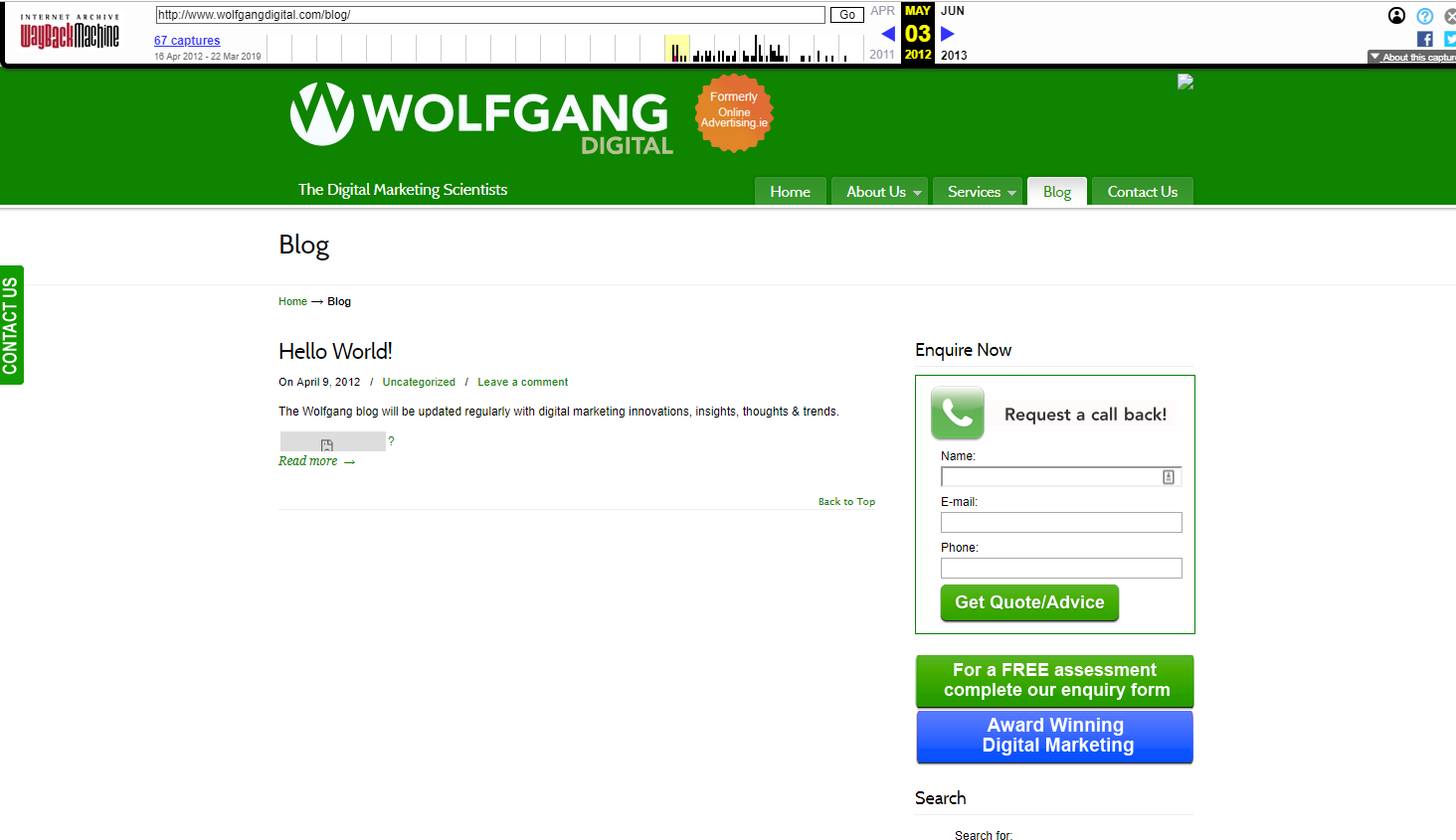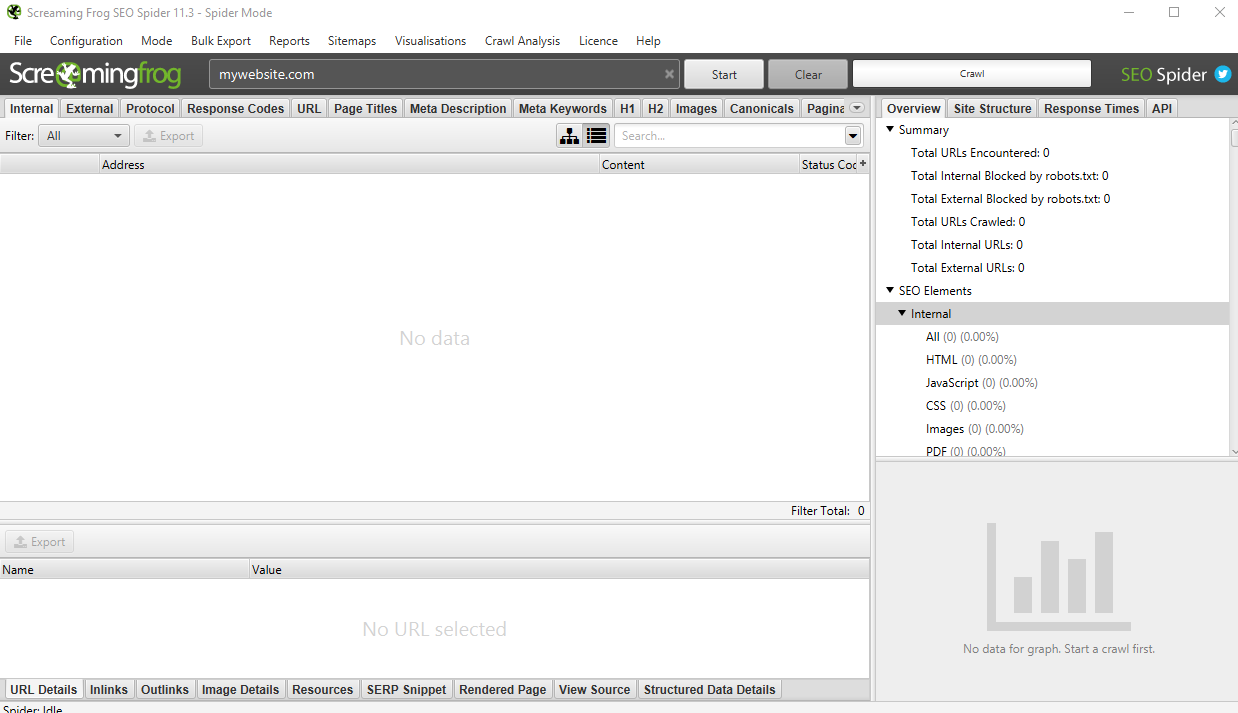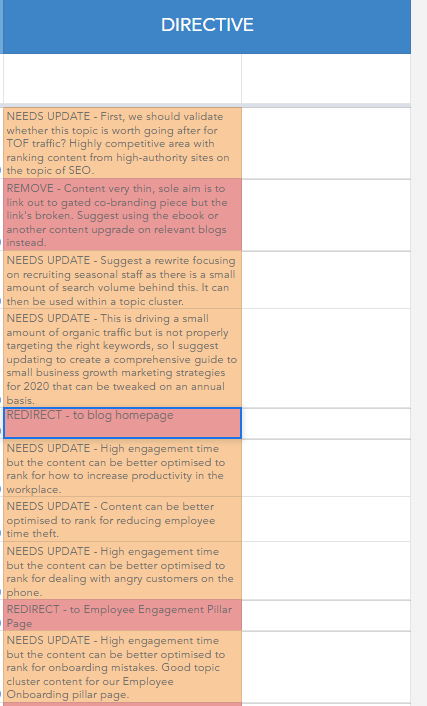By Kathy Deady on 13 Aug 2019

Okay, so you’ve got content. Loads of it, actually. But do you know what’s working and what isn’t?
A content audit is a bit like your annual check up at the doctors.
Essential to the health and longevity of your content marketing efforts, sure. But a bit unsettling to think about... and easily put on the long arm.
Here’s the thing, though: Whether you have a whole content strategy, calendar and a team in place, or you’re winging this whole contenting marketing jazz on your lonesome, you’re going to need to (and hopefully after reading this, want to) audit that blog.
And the sooner you do, the better off you’ll be.
First things first, download your free content audit template and read on.
How not to be a content marketing eejit (like me).
Before I started on Team Content at Wolfgang Digital, I was an in-house marketer (much like you might be), leading the content strategy for an online hiring platform for international educators.
I also inherited a blog that was a bit long in the tooth. This poor fella had, over the years, witnessed multiple Google algorithm updates, dozens of different content contributors and hundreds of blog posts of varying (and, I’m not going to lie to you, sometimes highly questionable) quality.
Of course, I was aware that the blog had its fair share of problems and weaknesses. Performance was a bit stagnant. We were seeing low double-digit organic traffic growth year over year by upping our posting frequency, but nothing to write home about.
Another dead giveaway: I’d occasionally look for relevant content to link out to within our newer pieces and cringe at what I found in the depths of the blog.
But... I always seemed to find an excuse to avoid delving too deeply into how the blog as a whole was performing.
Why?
Because of the same old daily marketing struggle we all have: It always felt like there was something more critical, more time sensitive, that warranted my attention.
New blog posts had to be written. Copy for new product launches and campaigns were added to the plate last minute. Content upgrades to drive conversions – someone had to create these! Not to mention, interactive content pieces that, if I’m being honest, just felt like a lot more fun to work on.
Cue blog audit on the perpetual back burner.
The fact that we were planning a website redesign and were in housekeeping mode in late 2017 was the final push I needed. But I’m ashamed to say it took me almost a year in the job before I bit the bullet and audited the blog.
With hindsight, I really, really wish I’d done it earlier.
Here’s why: As a direct result of the findings of our blog content audit, we made the decision to shift to a topic-cluster model for future content creation. We also uncovered a truckload of historical content optimisation opportunities that were ripe for the picking.
We got to work on overhauling our blog content in January 2018. By January 2019, we were seeing the following whopper results:
- 726% growth in year-over-year blog traffic (to 205,974 unique monthly pageviews!)
- 61% growth in year-over-year organic traffic sessions for the website overall.
- Oodles of top Google rankings for several critical top-of-funnel search queries, ranging from 9,900 to 18,100 average monthly searches per month.

It’s fair to say we were over the moon over in the marketing corner of the office.
But without that initial blog audit, we would never have seen the path clear to a massive win like this. We could well have stayed as we were; plodding along, seeing middling organic growth year over year. Living in blissful ignorance.
Recommended reading: The 5 Easiest SEO Wins You Can Make With Your E-Commerce Blog
That’s why it’s high time you audited that blog of yours.
Do a little experiment this week. Take a look at your own Google Analytics blog data. You’ll probably notice a few select posts are the workhorses of the whole operation, bringing in the bulk of organic traffic, while most articles drive little or no traffic.
If this is the case, then it’s time to get your audit on.
Now, I know a blog audit might not sound glamorous, exactly.
Thoughts like “snoozefest”, “spreadsheet-induced existential dread” or “I’d rather be audited by the Revenue than audit our blog in this lifetime” might well be springing to mind.
But, like it or not, you do need to audit your content.
(Or, *shameless plug* you could also talk to someone who can do the job for you, like Wolfgang’s crack team of content audit wizards.)
If you don’t, how will you have the first clue whether your content marketing is actually working?
What about those sleepless nights wondering about potentially massive problems that are going unfixed under your watch?
And (worst of all) what about those golden organic traffic opportunities that are right in front of you, just waiting to be unearthed via a glorious blog audit epiphany?
Right you are, but I’m still not 100% on what’s actually involved in a content audit...
A content audit involves tracking down, organising and assessing all of the content on your blog or website.
It offers a bird’s eye view of the current state of your content marketing to help you understand what’s working, what isn’t and what you can improve to get the results you need from all that hard work that’s been put into your content over the years.
The data you’ll uncover over the course of your content audit will help you suss out which blog posts are pulling in the most visits, highest user engagement and social shares, along with the stuff you’ve published that’s doing not much of anything at all for you.
In a nutshell, doing a blog audit is a bit like Marie Kondo-ing your content strategy. If your content doesn’t spark joy in you, how will it go over with your audience?
It’ll take some work (we recommend allocating up to a week for a decent-sized blog or website), but you’ll be happier and a lot more successful when you’re done.
What are some of the benefits of doing a content audit?
Before we dive into the things you should be keeping an eye out for as you're auditing your blog, let's quickly review some of the benefits of doing one:
1. It’ll help drive more organic traffic to your website.
It’s easy to work away in the weeds, posting new content week after week, chasing that initial traffic spike new blog posts tend to get.
But what you might not be aware of is the fact that too much content can actually be bad for your website. Especially stuff that’s irrelevant to the reader because it’s low quality, stale or doesn’t serve a purpose (i.e. answering their search intent).
You might feel a bit sickened at the prospect of losing content that hundreds of hours of work went into over the years. You might even be thinking “what’s the harm in keeping that stuff up, even if it’s a bit meh? No one really visits it anyway!”
Well, think again. This is exactly the kind of content that invariably has low engagement and will drag your site’s overall SEO performance down.
So don’t be a blog hoarder. Our pals over at Ahrefs, without creating ANY NEW CONTENT AT ALL, managed to grow their organic traffic, simply by removing a third of their content. If there’s lower-hanging fruit out there than a good old blog cull, we’ve yet to find it.
2. It’ll protect your site from Google penalties.
Unbeknownst to you, you might well have old content on your site that was made to game Google’s algorithm, and veers more towards the keyword-stuffy end of things. This is a huge no no – not only have Google got a whole lot smarter on that front, your competition have probably been busy upping their content game and are already outranking you for your target keywords anyway.
A blog post that ranked for you in 2012 (because Google were easier to trick back in the good old days), might be actively hurting your site right now. Uncovering the dodgier blogs on your site and updating or removing them will get you back into the almighty Googlebot’s good graces. (Not to mention your audience’s, who’ll be able to smell a keyword-stuffed rat a mile off.)
You probably have a few now-irrelevant blog posts that were written to fill a publishing quota, as well. We all have those skeletons in our content closet, so it’s time to dust everything off and see what needs to be confined to Wayback Machine for good (like our first-ever blog post):

3. You’ll find some hidden content gems along the way.
After years of creating content and multiple content creators, it’s all too easy to forget about some truly killer content assets you’ve already created that are flying under the radar and can easily be repurposed for different campaigns, personas or across different channels, like email or social.
This way, you’re maximising the value of what you’ve already got (and saving yourself a load of extra content grunt work in the process).
The step-by-step guide to conducting a content audit of your blog.
We’re not going to lie to you here, you’ll have to gather some pretty large amounts of data to actually complete your audit. This will involve a fair whack of manual work and hours.
We’ll share some of our tips and tricks to help speed the process up for you, but if you’re DIYing your content audit, you’ll need to be committed to a serious time investment upfront.
Step 1: Locate all of your content.
Any well-executed content audit begins with some detective work – you need to know exactly what it is you’re working with, after all.
The first step here is to compile a list of your URLs and pop them in a spreadsheet (or, you can use our free content audit template). If your website or blog is fairly compact, you might be able to gather your URLs manually.
If not, your sitemap or a website crawling tool like Screaming Frog can help you quickly find this data (and it’s free for up to 500 URLs). If your site is bigger than this, you’ll want the premium version (it’s what we use for content and SEO audits for our clients).
For each URL, you’ll want to record some page-specific data:
- Target keyword (you might be currently ranking for this, or not ranking at all)
- Title
- Inbound links
- Outbound links
- Meta description
- Meta description length (Head up, this should be under 60 characters to show up properly in Google)
- Page headings (H1, H2, etc.)
- Word count
- Publish date/last updated date (you can find this within the page source code)
If you opt for Screaming Frog for your initial data pull, all you have to do is plug in your domain name in the text bar at the top, and press “Start”:

(If you’re looking to audit your blog only, then you can choose to limit your crawl accordingly.)
When Screaming Frog is done doing its creepy-crawly thing, all you have to do is set the filter to HTML and export the data via a CSV file. From here, you’ll want to clean out any URLs that have a status code other than “200”.
You’ll also want to add a column in for the type of content (blog post, video, infographic. etc.) as well as the target persona and stage of the funnel each piece is aligned with.
Note: One piece of data that Screaming Frog can’t help you out with are your blog publication dates. But there’s a nifty little hack that Gustavo on our SEO team came up with to automate this process.
If you want to know how he does it, we recommend hitting him up on Twitter! You can also use his trick to locate the categories for all of your blog posts, which will come in super handy if you’re trying to cluster your content by topic.
Step 2: Compile all of your key content performance metrics.
You should be now at the final stage of the data gathering process.
Other critical metrics we recommend you collect include things like:
- Pageviews
- Unique visitors
- New visitors
- Time on page
- Bounce rate
- Pages per session
- Conversions (either goal completions or assisted conversions)
All of these can be found in Google Analytics, under “Behavior”. Next, you’ll need to dive into Google Search Console for these data points:
- Organic clicks
- Click-through rate
- Average keyword position
Knowing which pages generate the most social media shares and traffic can help you identify what is most effective with your audience. Other miscellaneous data points to collect include:
- Search volume (you can grab this from any keyword tool, like SEMRush and Google Keyword Planner)
- Page rank (again, there are a range of different tools you can call on for this info, like Ahrefs URL Rating and Moz’s Page Authority)
- Social shares (Depending on your business, you might want to break this down by social network. This info can be obtained via Buzzsumo or SharedCount.)
- Readability and read time (via URL Profiler)
Once you’ve pulled your mounds of data from all the different places, you'll need to match it up to the right URL your spreadsheet using VLOOKUP in Excel.
Be sure to keep the time frame consistent across all the different metrics you’re gauging so nothing’s getting skewed in the process. When we’re conducting a content audit on behalf of a client, we like to pull this data from the last 60 - 90 days, rather than a narrower time period (such as the past week or month). That way, we’re getting more of a long-range view of how your content is performing.
As mentioned, you can get most of this info in Google Analytics or Search Console, but manually extracting it all can be incredibly time consuming.
This is where using a paid KPI scraping tool like URL Profiler comes in handy.
Step 3: Complete your content analysis.
At this point, you’ll have collated all the necessary data. It’s time to start your content analysis. Here's where you’ll want to have a think about what you consider high or low performing content, too. You might want to set a minimum benchmark for the amount of pageviews each blog post needs to drive, for example.
We recommend diving deep into your top keywords, users, pageviews, bounce rate and backlinks. These are all great indicators of the type of content that goes over well with your readers. We also recommend you move out of the spreadsheet fog and actually review each blog post.
Is the tone consistent with your brand? Is it written in a clear, helpful and informative way? Is it scannable (i.e. broken up with bulleted and numbered lists, along with subheadings?) Are there any broken links within the body of the content? Make sure to take detailed notes of your observations on what needs to be fixed on each page on your audit spreadsheet.
Step 4: Set out your content audit directives.
It’s time to add perhaps the most critical column of all to your spreadsheet – your directives for each piece of content.
You can customise this whatever way works for your business, but chances are you’ll want to go for some variation of the following:
GOOD. This post is performing well and no changes are warranted. Is there a pattern to these successes that you can apply to future content? You’ll want to flag these as it could be worth producing more content related to the topic or structuring future blogs in a similar way.
LEAVE AS IS. It could be that updating this post would take more resources than the potential gains are ultimately worth to your business. Or this is more recent blog posts that need more time to garner rankings and traffic.
UPDATE. This is the content that you will need to edit, revise, or change in some way.
Maybe a particular blog post is getting traffic, but falling short in terms of conversions or user engagement? Maybe there’s critical gaps in the content as it stands or it needs a refresh as it’s an oldie? Maybe it’s ranking for high-value keywords but it’s not getting enough clicks relative to its position (or it’s ranking, but not on page one?)
Be sure to add specific notes on whether it needs a light update (i.e. the title and subheadings need to be fixed), whether it’s missing a Call to Action, or whether a total rewrite is called for.
REMOVE AND REDIRECT. This can be outdated, factually inaccurate, duplicate or low quality content with low traffic, a high bounce rate and low time on page.
CONSOLIDATE. Chances are, you’ll come across content pieces on very similar topics.
These ones, you’ll want to merge into one authoritative post on the topic to combat potential keyword cannibalisation. Here’s an example of how we’ve done it for one Wolfgang client:

It’s also a good idea to add in an extra column beside your Directives column, mapping out the content you’re going to be updating in order of priority. Go after the big wins first, which are likely the pages that are already generating the best results for your blog anyway.
At this juncture, you could even go one step further and estimate how much time each piece will take to get it up to snuff, as well as the person on your team who will ultimately be responsible for the work.
Step 5: Create a plan for new content creation and optimisation.
Your audit is complete. What comes next? Putting these incredible findings into action, of course!
There’s not much point to all that work if you don’t do anything with your findings. So start laying out a plan for how you’re going to apply your audit findings and making some serious content magic happen.
These will likely be split into two buckets:
- New content that needs to be created to fill existing gaps. Your competitors are likely targeting keywords that you’re not – this is the gap you’ll want to fill for your audience.
- Older content that needs to be optimised or otherwise updated.
You should now be able to pinpoint your most successful pieces of content, the topics that really resonate with your audience, the kinds of content assets that aren’t passing muster in terms of traffic, rankings and conversions, as well as the blog posts that are in need of an update.
Focus on the action points that will deliver long lasting results for your business, as well as the ones with a high return and the least amount of legwork. Think long term here – you’re not going to have that blog looking all spiffy in a couple of weeks. When done right, this process can take many weeks and months.
You might find pages with high impressions and low click-through rates – these might need nothing more than a meta description rejig.
There might be blog posts that on on the cusp of hitting page one of Google for a high-value keyword. Start with updates to the pages that rank in positions 2 - 10. If you can bump these babies up in the SERPs, you’ll easily double your traffic.
In terms of existing content optimisation, action points might include:
- Blogs that need some minor fixes, like rewriting the meta description, adding subheadings to chunkify the content a bit or updating internal links.
- Blogs that need a total revision and rewrite as the content is thin or inaccurate.
- Blogs on similar topics that need to be merged into one kickass post.
- Blogs that are outdated and/or irrelevant.
You want to keep your blog sustainable, useful and fresh. So make sure everything you’re keeping provides real value to the audience you’re trying to reach. Don’t be afraid to dump anything that doesn’t. (Remember, content that doesn’t provide any value could actually reduce rather than increase search engine visibility.)
We know. There’s a ton of work involved in auditing your content.
And it leads to even more work. But it’s so, so worth it. Now, post-audit, you could discover your blog is a bit of a shambles, but don’t panic about that.
Because we’ll let you in on a little secret: Most blogs that have been around for a while are in dire need of a content overhaul. This isn’t an issue that’s exclusive to your blog.
While it will take you some time, armed with your content audit findings, you’ll be well able to optimise your stale or underperforming content and start seeing some serious results.
Happy auditing! (Yep, that might be the first time that phrase has ever been uttered...)
Free Content Audit Template
Download our free content audit template here








